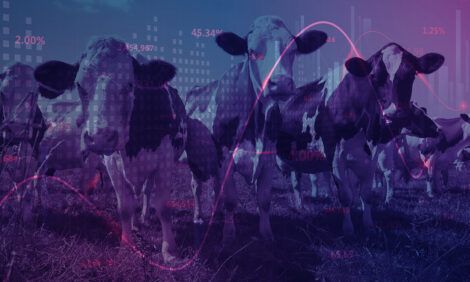



Weekly global protein digest: California to phase out ultra-processed food from school meals
Livestock analyst Jim Wyckoff reports on global protein news
California to phase out ultra-processed food from school meals
Governor Newsom signs landmark law with UPFs defined by 2028 to safeguard children’s health
Governor Newsom signed AB 1264, a first-in-the-nation law that will gradually eliminate ultra-processed foods (UPFs) from the state’s public school meal programs — a move hailed by public-health advocates as a major step toward protecting children from diet-related diseases. Authored by Assemblymember Jesse Gabriel (D–San Fernando Valley) and backed by bipartisan votes, the law provides the first statutory definition of ultra-processed foods in the United States and sets a multi-year schedule for phasing them out of school cafeterias.
“California has never waited for Washington or anyone else to lead on kids’ health,” Newsom said. “This first-in-the-nation law builds on our record of removing harmful additives and ensuring that every student has access to healthy, delicious meals that help them thrive.”
Retail chicken prices declining
Spot chicken prices in the U.S. have fallen 18% since their summer barbecue-season peak as supply is finally catching up with booming consumer demand, according to a Bloomberg report. Some of the largest global meat producers have leaned on poultry profits to cushion losses at their beef businesses, which have been impacted by the worst U.S. cattle shortage in decades. “Chicken producers continue to benefit from low feed costs and resilient demand, as consumers look for cheaper alternatives than pricey beef,” said the report. The U.S. has seen an increase in the number of chick placements, improved egg fertility rates and seasonally strong poultry slaughter numbers — all pointing to rising chicken meat supply. USDA has raised its 2025 broiler production estimate for four straight months.
Feeder cattle futures at record high
Feeder cattle futures led gains in the cattle futures markets Wednesday, with November feeders setting a record high. The live and feeder cattle bulls have once again shown incredible resilience after they were left for dead in mid-September. The live cattle futures bulls still have some stiff overhead technical resistance levels to overcome in order for new for-the-move highs to occur. USDA Wednesday reported very light cash cattle trade taking place at an average of $230.00 for steers and $228.00 for heifers. Cash cattle trading last week averaged $230.76. That’s down $1.89 from the prior week’s average of $232.65.
UN’s global meat price index hits record high
Global meat prices hit a fresh record high in September — in the longest run of monthly gains since 2021 — as shrinking U.S. cattle herds are unable to keep up with strong demand for beef. An index tracking meat-commodity costs rose 0.7% for an eighth straight monthly increase, the United Nations’ Food and Agriculture Organization said Friday. The rally has been largely driven by rising beef prices — with the U.S. cattle herd reaching the smallest in decades, higher prices in top exporter Brazil, and worries over the deadly New World Screwworm pest in Mexico. In the U.S., “limited domestic supplies and favorable price differentials continued to encourage beef imports, especially from Australia where prices rose,” the FAO said in its report. “Brazilian bovine prices increased as well, underpinned by robust global demand, offsetting reduced access to the U.S. following the imposition of higher tariffs.”
Weekly USDA dairy report
CME GROUP CASH MARKETS (10/3) BUTTER: Grade AA closed at $1.7500. The weekly average for Grade AA is $1.7390 (+0.0670). CHEESE: Barrels closed at $1.7700 and 40# blocks at $1.7900. The weekly average for barrels is $1.7100 (+0.0790) and blocks $1.7410 (+0.1125). NONFAT DRY MILK: Grade A closed at $1.1600. The weekly average for Grade A is $1.1580 (+0.0105). DRY WHEY: Extra grade dry whey closed at $0.6300. The weekly average for dry whey is $0.6410 (-0.0030).
BUTTER HIGHLIGHTS: Domestic butter demand is mixed throughout the country. Retail sales activity remains more robust than food service sales activity. Export demand is strong for the most part. Cream is readily available across the country. Lower cream multiples were generally reported in week 40 compared to the prior week. Butter producers noted mixed demand for spot loads of cream. Butter production schedules vary from steady to strong. Production managers are more focused on retail butter production than bulk butter production. Butter stocks are more than ample to meet buyer demands. Bulk butter overages range from 2 cents below to 5 cents above market across all regions.
CHEESE HIGHLIGHTS: Cheese output in the East is steady as producers balance limited capacity at a few facilities with strong retail and holiday order fulfillment. Spot milk is available for Class III use, helping plants keep inventories in line. Export demand is steady, and overall supply and demand remains well aligned. Cooler fall conditions are supporting stronger milk flows in the Central region, giving processors a bit more to work with. Cheese production is steady, though spot milk availability is light. Retail and food service demand are consistent, with export interest staying strong. Spot loads are limited, but accessible to meet current needs. Cheese makers in the West are leaning on contract milk, while also finding spot volumes available. Milk output continues to improve from summer levels, and production schedules vary from steady to stronger. Domestic demand is moderate, while export interest remains a key driver. Market activity is firm, and CME prices showed notable daily strength this week.
FLUID MILK HIGHLIGHTS: Milk production continues to rise nationwide. Decreasing temperatures are increasing cow comfort, leading to larger volumes of milk. Milk components remain high, higher than many contacts can remember in recent years. Class I demand remains strong. Bottling demand is increasing in the Midwest while the rest of the country is in a steady state. Class II demand is seasonally increasing. Manufacturers are fulfilling holiday orders for dairy-based baking ingredients. Class III demand is steady to light nationwide. The Midwest is seeing a drop in spot trades for Class III milk. Spot prices for Class III milk range from $1.5 under to $1 over. Cream is plentiful in all regions. Class IV demand is holding steady, but the increase of cream to the market is driving cream multiples down. Cream destined for churns is, in some cases, selling below flat value. Condensed skim demand is mixed. There is a large supply of condensed skim on the market. Prices for condensed skim range from $0.30 under to $0.15 over Class price. Cream multiples for all Classes range: 1.00 – 1.24 in the East; 0.85 – 1.23 in the Midwest; 0.86 – 1.18 in the West.
DRY PRODUCTS HIGHLIGHTS: Prices for low/medium heat nonfat dry milk (NDM) declined across the price range in the Central and East regions and at the bottom of the West range. The mostly price series for low/medium heat NDM shifted lower in all regions this week. High heat NDM prices also shifted lower. Prices decreased at the bottom of the Central and East buttermilk price range, but were steady at the top and across the range in the West. Central region dry whey prices increased across the range and mostly price series, but dry whey prices were unchanged in the East and West regions. The price range for lactose expanded, with the bottom moving lower and the top pushing higher, while the mostly price series was unchanged. Whey protein concentrate prices were unchanged at the top of the range and across the mostly price series but moved lower at the bottom of the range. Prices for dry whole milk decreased across the range. Acid casein prices increased at the bottom of the range. The bottom of the rennet casein price range held steady, but the tops of the acid and rennet casein ranges both moved lower.
ORGANIC DAIRY MARKET NEWS: The NOP Organic Insider from October 1 contained an update for the Fall 2025 National Organic Standards Board (NOSB) meeting, currently scheduled for November 4 6 in Omaha, NE. The NOP is listed as an activity that does not operate during a government shutdown (per the USDA Lapse in Appropriations Plan). If NOP employees return from furlough by 9am Eastern on October 16, the meeting will remain in place as an in-person and virtual event. European organic milk average pay prices for July 2025 increased in Austria, France, Germany, and Bavaria compared to June. The average pay price in July 2025 was up from a year ago in Austria, France, Germany, and Bavaria. The following was reported by USDA AMS Livestock, Poultry, and Grain Market News (LPGMN) in the National Organic Grain and Feedstuffs Report. Compared to the last period, trading is active with moderate to good demand for organic feed corn. Farmers have started harvesting new crop corn and soybeans in the Midwest region.
FINAL CLASS PRICES (FMMO): The following are the September 2025 class prices under the Federal milk order pricing system and changes from the previous month: Class II: $17.39 ($-1.79), Class III: $17.59 ($+0.35), and Class IV: $16.17 ($-2.33). Under the Federal milk order pricing system, the butterfat price for September 2025 is $2.1925 per pound. Thus, the Class II butterfat price is $2.1995 per pound. The protein and other solids prices for September 2025 are $2.7062 and $0.3207 per pound, respectively. These component prices set the Class III skim milk price at $10.28 per cwt. The September 2025 Class IV skim milk price is $8.80, which is derived from the nonfat solids price of $0.9773 per pound. The product price averages for September 2025 are: butter $2.0377, nonfat dry milk $1.2265, cheese $1.8066, and dry whey $0.5782.
AUGUST COLD STORAGE REPORT (NASS): Total natural cheese stocks in refrigerated warehouses on August 31, 2025, were down 0.8 percent from the previous month but up 1.7 percent from August 31, 2024. Butter stocks were down 7.7 percent from last month and down 5.7 percent from a year ago. AUGUST AGRICULTURAL PRICES (NASS): The All-Milk price received by farmers was $20.90 in August, down $2.70 from August 2024. The alfalfa hay price was $166.00 in August, down $9.00 from August 2024. The corn price was $3.96 in July, up $0.12 from August 2024. The soybean price was $10.00 in August, down $0.30 from August 2024. The milk-feed price ratio was 2.51 in August, down 0.28 from August 2024. The index of prices received by farmers during the month of August 2025 was up 1.3 to 137.7 compared to the prior month and up 9.3 points (7.2 percent) from the prior year. The index of prices paid by farmers for commodities and services, interest, taxes, and wage rates in August 2025 was 152.0, up 1.3 from the prior month and up 13.7 points (9.9 percent) from the prior year.
NATIONAL RETAIL REPORT: Both conventional and organic dairy ads increased 13 percent in the week 40 retail dairy survey. The most advertised conventional commodity is cheese, and milk is the most advertised organic commodity. Conventional cheese ads declined by 7 percent, while organic cheese ads are up 5 percent. Ice cream, the second most advertised conventional commodity, is featured in 38 percent more ads this week. Ads for conventional yogurt are down 16, but organic yogurt ads grew 95 percent.



